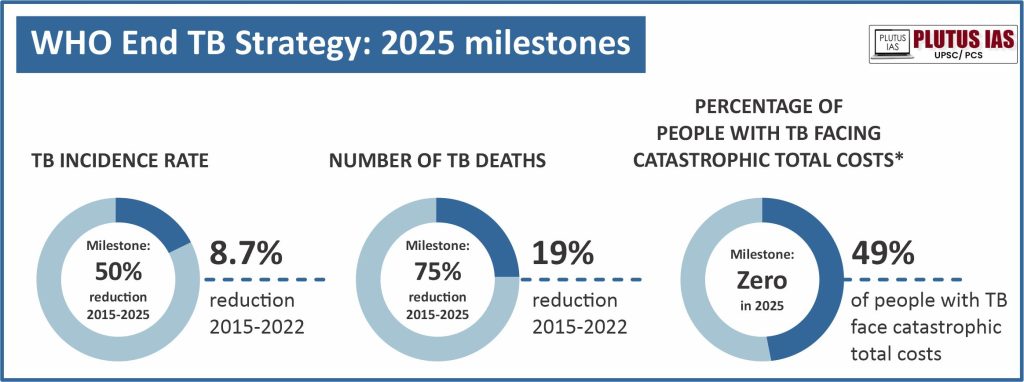29 Mar India TB Report 2024
This article covers ‘Daily Current Affairs’ and the topic details of ”India TB Report 2024″. This topic is relevant in the “Social Issues” section of the UPSC CSE exam.
Why in the News?
As per the India TB Report 2024 published by the Union Health Ministry, the disparity between the projected and confirmed cases of tuberculosis (TB) is diminishing.
Significant Findings of the Report
Closing the Gap on Missed Cases
A significant drop in undetected TB cases is a major victory. In 2023, the number of missing cases fell to 2.3 lakh, compared to 3.2 lakh the year before. This progress is attributed to improved tracking through the Ni-kshay portal, a centralised platform for TB management.
Boosting Private Sector Involvement
Private healthcare providers are playing an increasingly important role in TB detection. In 2023, nearly one-third (8.4 lakh) of reported cases came from the private sector, compared to a mere 1.9 lakh in 2015. This collaboration strengthens India’s overall detection capacity.
Refined Estimates for a Clearer Picture
India’s new TB incidence estimates, accepted by the World Health Organization (WHO), offer a more precise understanding of the disease burden. While the estimated incidence increased slightly to 27.8 lakh in 2023, the mortality rate remained stable at 3.2 lakh. This new model led to a significant adjustment in global TB mortality figures reported by the WHO.
Treatment on Track
India successfully achieved its target of initiating treatment in 95% of diagnosed TB patients in 2023. This ensures timely access to life-saving medication.
Battling Drug Resistance
- The fight against drug-resistant TB is gaining ground. The percentage of patients tested for medication resistance jumped from 25% in 2015 to 58% in 2023. This allows for early detection and prompt administration of appropriate treatments.
- India’s comprehensive approach towards TB detection, treatment, and drug resistance is yielding positive results. Continued efforts are crucial to further reduce the TB burden and ultimately eliminate the disease.
About Tuberculosis
- Tuberculosis (TB) casts a long shadow on global health. Caused by the bacterium Mycobacterium tuberculosis, TB is a major infectious disease with a concerning prevalence.
- While treatable and curable, TB remains the world’s leading infectious killer, taking millions of lives annually. This highlights the critical need for continued efforts in prevention, diagnosis, and treatment.
- In humans, TB primarily targets the lungs (pulmonary TB), but it can spread and cause extra-pulmonary TB in other organs. This versatility of the bacteria and the potential for severe illness make TB a global public health concern.
- The history of TB stretches back millennia, with evidence of the disease documented in Egypt as early as 3000 BC. This demonstrates the enduring nature of TB and the ongoing challenge it presents.
- The burden of TB is particularly heavy in low- and middle-income countries. Eight nations – Bangladesh, China, India, Indonesia, Nigeria, Pakistan, Philippines, and South Africa – account for nearly half of all TB cases globally. This uneven distribution underscores the need for a global approach to combating TB.
Combating Tuberculosis
- The first line of defence is a 6-month regimen of four antibiotics combined with patient education and support. This approach improves completion rates and reduces resistance.
The Challenge of Resistance
Decades of antibiotic use have led to resistant strains. These strains, documented worldwide, highlight the need for proper antibiotic use to minimise resistance.
- MDR-TB: Multidrug-resistant tuberculosis (MDR-TB) is a serious form where bacteria resist the two most powerful first-line drugs. Thankfully, MDR-TB is treatable with alternative drugs, but this emphasises the need for new medications.
- XDR-TB: Extensively drug-resistant TB (XDR-TB) is resistant to many effective drugs, limiting treatment options. Stricter adherence to protocols, research into new antibiotics, and advocating for proper medication use are all crucial to combating drug resistance and ensuring effective TB treatment.

Initiatives taken to combat Tuberculosis
- Ni-kshay Portal: This government platform acts as a central hub for TB notification, treatment management, and patient tracking. It facilitates better monitoring and reduces the number of missed cases.
- Ni-kshay Poshan Portal: It’s a financial incentive program under India’s National Health Mission. Registered TB patients receive a monthly cash transfer of Rs. 500 to help them meet their nutritional needs during the 6-month treatment period, improving treatment adherence and overall health outcomes.
- TB-Mukt Bharat Abhiyan: It aims to raise public awareness about TB in order to reduce stigma and encourage people to seek diagnosis and treatment.
Download plutus ias current affairs eng med 29th March 2024
Prelims practice questions
Q1. How does the Nikshay portal contribute to national TB control programs?
(a) By providing funding for TB treatment
(b) By facilitating collaboration between healthcare providers
(c) By monitoring progress and evaluating program effectiveness
(d) By conducting TB research studies
Answer: C
Q2. Consider the following statements:
- HIV/AIDS increases the risk of drug-resistant TB
- Levofloxacin is a second-line drug used to treat drug-resistant TB
- Both healthcare providers and government officials can access the Nikshay portal
How many of the statements above are correct?
(a) Only one
(b) Only two
(c) All three
(d) None
Answer: C
Upsc mains questions
Q1. compare and contrast the transmission, symptoms, and treatment approaches for drug-sensitive TB and extensively drug-resistant TB (XDR-TB). How does the prevalence of XDR-TB affect healthcare systems and patient outcomes?
Q2. Compare and contrast the transmission, symptoms, and treatment approaches for drug-sensitive TB and extensively drug-resistant TB (XDR-TB). How does the prevalence of XDR-TB affect healthcare systems and patient outcomes?
I am a content developer and have done my Post Graduation in Political Science. I have given 2 UPSC mains, 1 IB ACIO interview and have cleared UGC NET JRF too.



No Comments